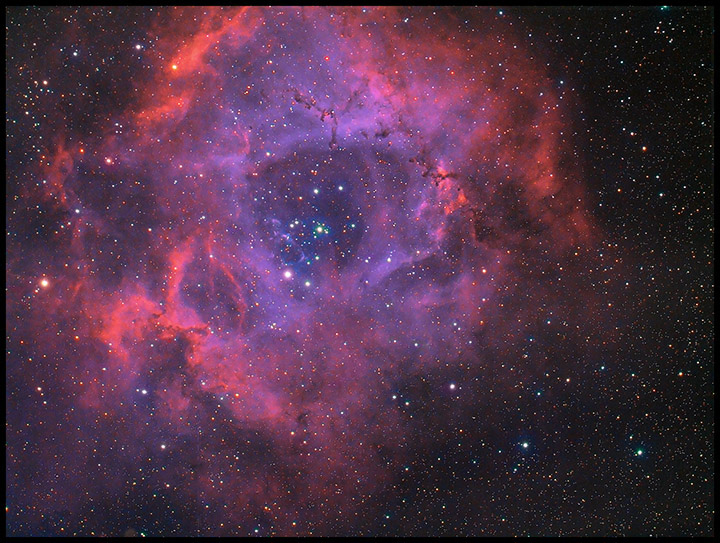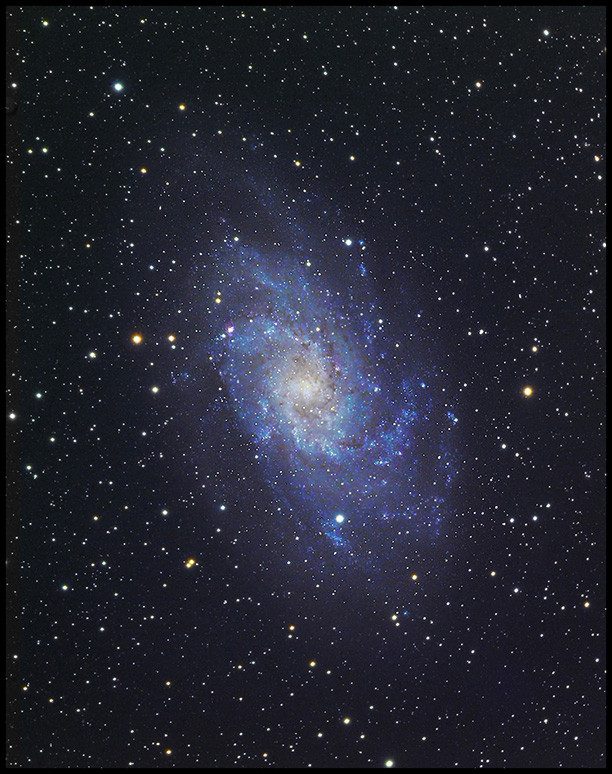Pinwheel and Rosette
12/01/2016. The sky wasn't supposed to be this clear tonight, but since it was, I put the TMB92SS back on the Mach1, remounted the CCD, and went after some big, easy targets. The Rosette Nebula and cluster in Monoceros was actually the last target of the night, the one I set up, started, and then walked away from to get some sleep.

The Rosette
12x900s hydrogen-alpha + 1x300s RGB (3h15m)
Click for a better look.
I started with the Iris Nebula (NGC 7023), but it's resisted all efforts to produce a photogenic result, so nevermind that for now. Its faint bits are very faint, and its bright bits are very bright. Color is elusive in all but the brightest sections. It leads to mayhem.
I revisited M33, a soft, moon-sized pile of faintness in Triangulum. I've never had much trouble with it, but some people find it tough visually. It's easy and bright photographically, though. I took 3 hours of luminance data (only) since I already had good RGB and combined all the luminance into one heap:

M33
59x300s L plus 2x300s RGB (5h15m)
Sure, go ahead and click.
Technical innovation for the night: anti-gravity assist for the focuser. I really wouldn't expect a 3-inch Feathertouch focuser to let an SBIG ST2000XM and CFW10 boss it around, but I've caught the focus changing slowly in overnight runs, too much to attribute to thermal contraction. Also, the compression ring allows the 2-inch TeleVue snout on the flattener to tilt unless it is tightened down to the point that I begin to worry about stripping threads with the compression ring placed entirely within the "notch" on the barrel. I addressed both issues with an arrangement of bungee cords last night to take some of the weight off the focuser and to ensure that whatever tilt the system has, it stays constant through an observing run. Seems to have stopped any creep and tilt for one night at least. An extra-firm twist on the focuser brake didn't hurt either.
My deep-sky photos are made with a variety of sensors and optics. Deepest images usually come from a SBIG ST2000XM CCD behind a 10-inch Astro-Tech Ritchey-Chretien carried on an Astro-Physics Mach1GTO. The CCD is equipped with a CFW-10 loaded with Baader wide- and narrow-band filters. Camera control and guiding are handled by Maxim DL 5.12. A Canon 6D and a modded 50D find themselves mounted behind an Orion 10" F4 Newtonian or a 92mm Thomas Back refractor or a tiny but mighty AT65EDQ refractor, sometimes with Backyard EOS in control and PHD Guide keeping things on target. Really widefield photos are often made using the 6D and various camera lenses and an iOptron Skytracker mount. PixInsight does most of the heavy lifting in post-processing — alignment, stacking, gradient removal, noise-reduction, transfer function modification, color calibration, and deconvolution. Photoshop along with Focus Magic and a handful of other plugins get their licks in, too, especially when polishing for the web.
:: top ::